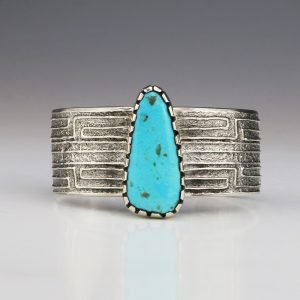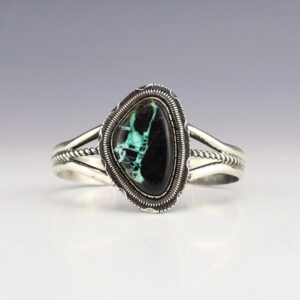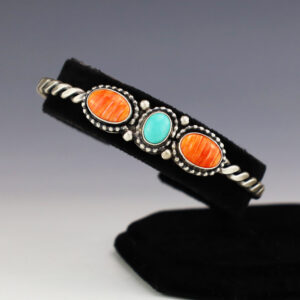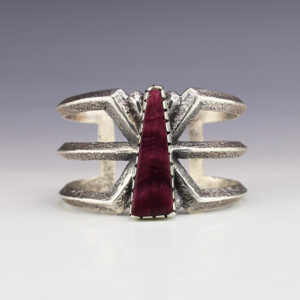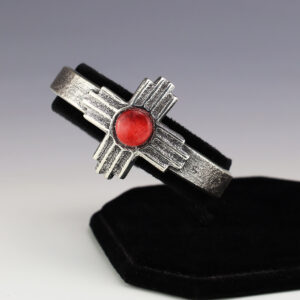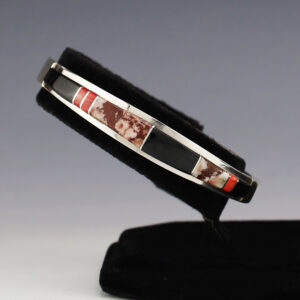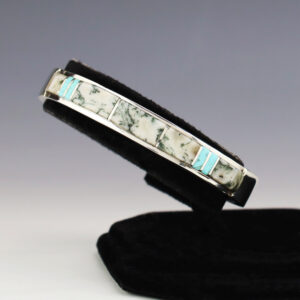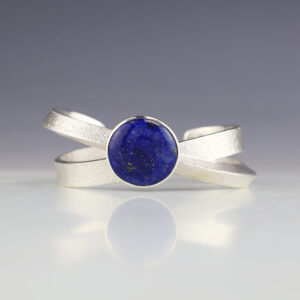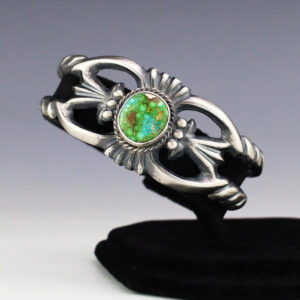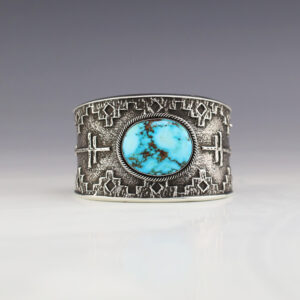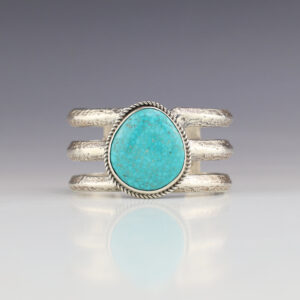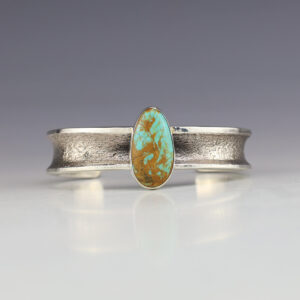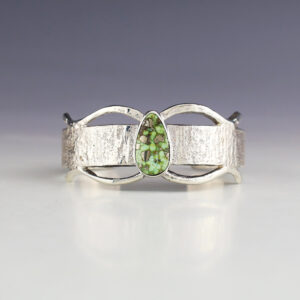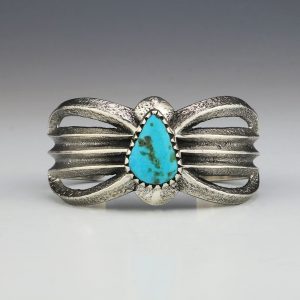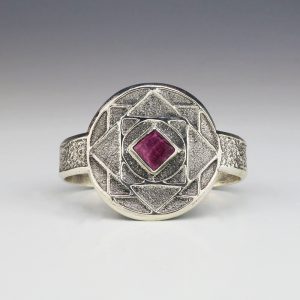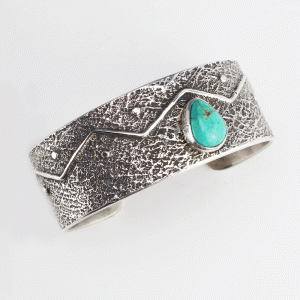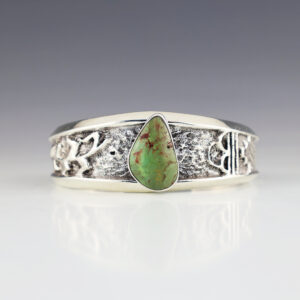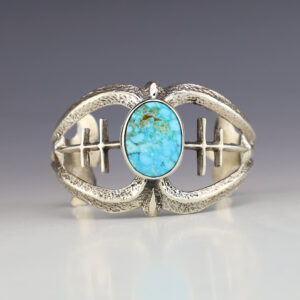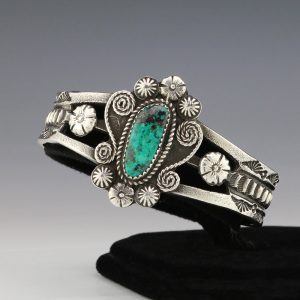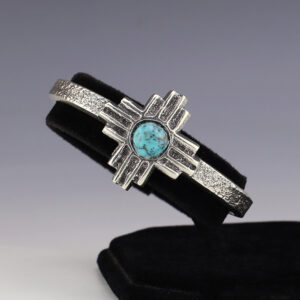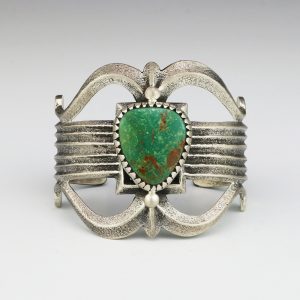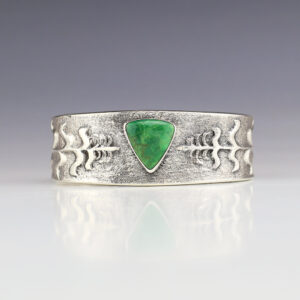DRAGONFLY SLEEPING BEAUTY TURQUOISE BRACELET BY GARY CUSTER NAVAJO 6 1/2
In the mid 1800s, Navajo silversmiths started to use sand casting as one of their silversmithing techniques. Today, silversmiths still use this technique by carving a design in tufa stone (a porous limestone) and then placing another stone against it. The two pieces are fastened together and molten silver is...
KINGMAN TURQUOISE BRACELET BY GARY CUSTER NAVAJO
In the mid 1800s, Navajo silversmiths started to use sand casting as one of their silversmithing techniques. Today, silversmiths still use this technique by carving a design in tufa stone (a porous limestone) and then placing another stone against it. The two pieces are fastened together and molten silver is...
NATIVE AMERICAN NAVAJO STERLING SILVER & BLACKJACK TURQUOISE BRACELET BY WALTER VANDEVER 6 3/4
Navajo artist Walter Vandever made this gorgeous bracelet out of sterling silver and set it with a Blackjack Turquoise stone. Weighs 38 grams. The entire inner circumference is about 6 3/4”, including 1 1/8” opening. (Fits a 6 3/4″ wrist) Signed tapers 3/8″ to 1 5/8” wide Artist...
NATIVE AMERICAN NAVAJO SPINY OYSTER & TURQUOISE BRACELET 7 5/8
Gorgeous bracelet out of sterling silver and set it with Spiny Oyster and Turquoise stones. Weighs 18 grams. The entire inner circumference is about 7 5/8”, including 1” opening. (Fits a 7 5/8″ wrist) Signed 3/16” wide -bracelet 9/16” wide -stones The Navajos began working with silver in...
NATIVE AMERICAN NAVAJO SPINY OYSTER BRACELET BY GARY CUSTER
In the mid 1800s, Navajo silversmiths started to use sand casting as one of their silversmithing techniques. Today, silversmiths still use this technique by carving a design in tufa stone (a porous limestone) and then placing another stone against it. The two pieces are fastened together and molten silver is...
NATIVE AMERICAN NAVAJO SPINY OYSTER ZIA BRACELET BY GARY CUSTER
In the mid 1800s, Navajo silversmiths started to use sand casting as one of their silversmithing techniques. Today, silversmiths still use this technique by carving a design in tufa stone (a porous limestone) and then placing another stone against it. The two pieces are fastened together and molten silver is...
NATIVE AMERICAN NAVAJO STERLING SILVER & AURORA OPAL BRACELET GARY CUSTER
In the mid 1800s, Navajo silversmiths started to use sand casting as one of their silversmithing techniques. Today, silversmiths still use this technique by carving a design in tufa stone (a porous limestone) and then placing another stone against it. The two pieces are fastened together and molten silver is...
NATIVE AMERICAN NAVAJO STERLING SILVER & INLAY BRACELET BY KYLE YELLOWHAIR 6 1/2
Navajo artist Kyle Yellowhair made this gorgeous bracelet out of sterling silver and set it with Spiny Oyster, Jet, and Wild Horse stones. Weighs 22 grams. The entire inner circumference is about 6 1/2”, including 1 1/8” opening. (Fits a 6 1/2″ wrist) Signed tapers 3/16″ to 3/8” wide ...
NATIVE AMERICAN NAVAJO STERLING SILVER & INLAY BRACELET BY KYLE YELLOWHAIR 6 1/2
Navajo artist Kyle Yellowhair made this gorgeous bracelet out of sterling silver and set it with White Buffalo and Turquoise stones. Weighs 26 grams. The entire inner circumference is about 6 1/2”, including 1 3/16” opening. (Fits a 6 1/2″ wrist) Signed 3/8” wide Artist card included ...
NATIVE AMERICAN NAVAJO STERLING SILVER & LAPIS BRACELET BY KELSEY JIMMIE
In the mid 1800s, Navajo silversmiths started to use sand casting as one of their silversmithing techniques. Today, silversmiths still use this technique by carving a design in tufa stone (a porous limestone) and then placing another stone against it. The two pieces are fastened together and molten silver is...
NATIVE AMERICAN NAVAJO STERLING SILVER & LAPIS DRAGONFLY BRACELET GARY CUSTER 6 1/2
In the mid 1800s, Navajo silversmiths started to use sand casting as one of their silversmithing techniques. Today, silversmiths still use this technique by carving a design in tufa stone (a porous limestone) and then placing another stone against it. The two pieces are fastened together and molten silver is...
NATIVE AMERICAN NAVAJO STERLING SILVER & SONORAN GOLD TURQUOISE BRACELET BY HARRISON BITSUE 6 1/2
Navajo artist Harrison Bitsue made this gorgeous bracelet out of sterling silver and set it with a Sonoran Gold Turquoise stone. Weighs 40 grams. The entire inner circumference is about 6 1/2”, including 1 3/16” opening. (Fits a 6 1/2″ wrist) Signed tapers 3/8″ to 1 1/8” wide ...
NATIVE AMERICAN NAVAJO STERLING SILVER & SPINY OYSTER CORN BRACELET GARY CUSTER
In the mid 1800s, Navajo silversmiths started to use sand casting as one of their silversmithing techniques. Today, silversmiths still use this technique by carving a design in tufa stone (a porous limestone) and then placing another stone against it. The two pieces are fastened together and molten silver is...
NATIVE AMERICAN NAVAJO STERLING SILVER & TURQUOISE BRACELET BY AARON ANDERSON 6 3/4
In the mid 1800s, Navajo silversmiths started to use sand casting as one of their silversmithing techniques. Today, silversmiths still use this technique by carving a design in tufa stone (a porous limestone) and then placing another stone against it. The two pieces are fastened together and molten silver is...
NATIVE AMERICAN NAVAJO STERLING SILVER & TURQUOISE BRACELET BY GARY CUSTER
In the mid 1800s, Navajo silversmiths started to use sand casting as one of their silversmithing techniques. Today, silversmiths still use this technique by carving a design in tufa stone (a porous limestone) and then placing another stone against it. The two pieces are fastened together and molten silver is...
NATIVE AMERICAN NAVAJO STERLING SILVER & TURQUOISE BRACELET BY GARY CUSTER
In the mid 1800s, Navajo silversmiths started to use sand casting as one of their silversmithing techniques. Today, silversmiths still use this technique by carving a design in tufa stone (a porous limestone) and then placing another stone against it. The two pieces are fastened together and molten silver is...
NATIVE AMERICAN NAVAJO STERLING SILVER & TURQUOISE BRACELET BY GARY CUSTER 6 1/2
In the mid 1800s, Navajo silversmiths started to use sand casting as one of their silversmithing techniques. Today, silversmiths still use this technique by carving a design in tufa stone (a porous limestone) and then placing another stone against it. The two pieces are fastened together and molten silver is...
NATIVE AMERICAN NAVAJO TURQUOISE BRACELET BY GARY CUSTER
In the mid 1800s, Navajo silversmiths started to use sand casting as one of their silversmithing techniques. Today, silversmiths still use this technique by carving a design in tufa stone (a porous limestone) and then placing another stone against it. The two pieces are fastened together and molten silver is...
NAVAJO KINGMAN TURQUOISE BRACELET BY GARY CUSTER
In the mid 1800s, Navajo silversmiths started to use sand casting as one of their silversmithing techniques. Today, silversmiths still use this technique by carving a design in tufa stone (a porous limestone) and then placing another stone against it. The two pieces are fastened together and molten silver is...
NAVAJO SPINY OYSTER BRACELET BY GARY CUSTER
In the mid 1800s, Navajo silversmiths started to use sand casting as one of their silversmithing techniques. Today, silversmiths still use this technique by carving a design in tufa stone (a porous limestone) and then placing another stone against it. The two pieces are fastened together and molten silver is...
NAVAJO STERLING SILVER & SONORAN GOLD TURQUOISE BRACELET BY GARY CUSTER 6 3/4
In the mid 1800s, Navajo silversmiths started to use sand casting as one of their silversmithing techniques. Today, silversmiths still use this technique by carving a design in tufa stone (a porous limestone) and then placing another stone against it. The two pieces are fastened together and molten silver is...
NAVAJO STERLING SILVER & TURQUOISE BRACELET BY GARY CUSTER
In the mid 1800s, Navajo silversmiths started to use sand casting as one of their silversmithing techniques. Today, silversmiths still use this technique by carving a design in tufa stone (a porous limestone) and then placing another stone against it. The two pieces are fastened together and molten silver is...
NAVAJO STERLING SILVER & TURQUOISE BRACELET BY GARY CUSTER
In the mid 1800s, Navajo silversmiths started to use sand casting as one of their silversmithing techniques. Today, silversmiths still use this technique by carving a design in tufa stone (a porous limestone) and then placing another stone against it. The two pieces are fastened together and molten silver is...
NAVAJO STERLING SILVER & TURQUOISE BRACELET BY GARY CUSTER
In the mid 1800s, Navajo silversmiths started to use sand casting as one of their silversmithing techniques. Today, silversmiths still use this technique by carving a design in tufa stone (a porous limestone) and then placing another stone against it. The two pieces are fastened together and molten silver is...
NAVAJO STERLING SILVER & TURQUOISE BRACELET BY GARY CUSTER 6 5/8
In the mid 1800s, Navajo silversmiths started to use sand casting as one of their silversmithing techniques. Today, silversmiths still use this technique by carving a design in tufa stone (a porous limestone) and then placing another stone against it. The two pieces are fastened together and molten silver is...
NAVAJO STERLING SILVER & TURQUOISE BRACELET BY KEVIN BILLAH
Navajo silversmith Kevin Billah made this outstanding bracelet out of sterling silver and Turquoise. The entire inner circumference is about 6 1/2”, including 1 1/8” opening. (Fits a 6 1/2″ wrist) Weighs 42 grams. Signed. 1 7/16″ wide Artist card included The Navajos began working with silver in the...
NAVAJO TURQUOISE ZIA BRACELET BY GARY CUSTER
In the mid 1800s, Navajo silversmiths started to use sand casting as one of their silversmithing techniques. Today, silversmiths still use this technique by carving a design in tufa stone (a porous limestone) and then placing another stone against it. The two pieces are fastened together and molten silver is...
ROYSTON TURQUOISE BRACELET BY GARY CUSTER NAVAJO
In the mid 1800s, Navajo silversmiths started to use sand casting as one of their silversmithing techniques. Today, silversmiths still use this technique by carving a design in tufa stone (a porous limestone) and then placing another stone against it. The two pieces are fastened together and molten silver is...
STERLING SILVER & TURQUOISE BRACELET BY GARY CUSTER NAVAJO
In the mid 1800s, Navajo silversmiths started to use sand casting as one of their silversmithing techniques. Today, silversmiths still use this technique by carving a design in tufa stone (a porous limestone) and then placing another stone against it. The two pieces are fastened together and molten silver is...


